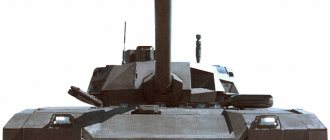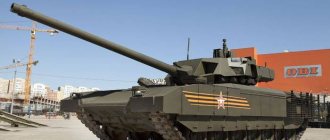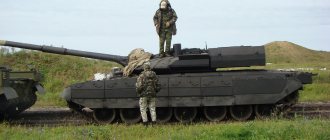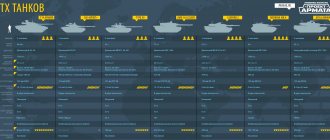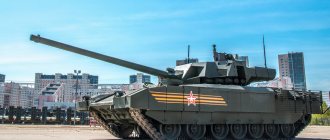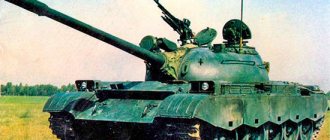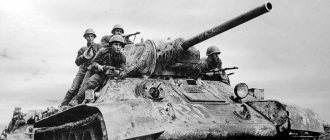From 2022, the Russian army plans to re-equip with a new generation of tanks, which will increase the share of the latest tanks to 70% of the total by 2022. Thus, it is planned to produce about 2,300 units of new combat vehicles.
At the moment, the development of the fourth generation tank T 99 is in the final stages. Naturally, we do not yet have details about the equipment and technical characteristics of the tank. Since the T 99 type is still being developed, all information about it is unverified. According to rumors, the model will have a completely new automatic projectile feeder, an improved ammunition removal mechanism and much more. It is noteworthy that the new Russian T-99 tank will accommodate about three dozen different shells.
It is also currently known that the model will be developed on the Armata unified tracked platform, which is used for vehicles weighing from 30 to 65 tons. According to preliminary data, the new vehicle will be a less revolutionary technological solution than the failed T-95. The T 99 model will weigh less, which will make it mobile, but at the same time less expensive.
Development of the T-99 began in 2010. UKBTM (Nizhny Tagil) and Uralvagonzavod (UVZ) took part in it. Serial production is planned to begin at the end of 2022 with funding of 150 billion rubles.
Main technical characteristics
- Layout. The platform on which the T 99 will be produced has two layout options: a chassis with a front or rear engine-transmission compartment (PMTO or ZMTO).
- Transmission. The model will be equipped with a 6-roller suspension controlled by vane shock absorbers, as well as a differential steering mechanism with hydrostatic transmission (GOP). The gearbox is 12-speed with the ability to switch to manual mode.
- Controls. Steering wheel, gear shift lever, gas and brake pedals.
- Power point. Turbopiston engine A-85-3A for front- and rear-mounted MTO.
- Motor resource. At least 2000 hours.
- Weight. No more than 55 tons.
- Platform volume. No more than 4 m3.
- Crew. 2 people: commander-gunner-gunner, driver with duplicate fire controls.
Communications and surveillance
It is known that the T-90AM has a turret with the Kalina multifunctional complex, which was first announced as an innovative development for the T-90.
- commander's panoramic sight Hawkeye;
- automated target tracking system;
- Sosna-U gunner's sight, which includes a laser range finder and thermal imager;
- complex of tactical level control systems;
- target recognition functionality based on the friend/foe principle;
- software for interaction between combat units within a battalion;
- complex for controlling smoke screens;
- terrain orientation system based on GPS and GLONASS;
- radio equipment for internal communication and external interaction.
Weapons and equipment
The new model will presumably be equipped with a 140-150 mm smoothbore tank gun with a new type of machine gun, as well as stabilization in two planes. In this case, the ammunition will be at least 30 rounds, the ammunition load will be from 700 rounds. The new model will also have a 12.7 mm stabilized high-precision machine gun with a barrel elevation angle of up to 90 degrees and the ability to rotate 360 degrees in the horizontal plane.
As for equipment, the T 99 will use a completely new fire control system, life support system, surveillance system, as well as an active protection system. These innovative systems currently have no analogues. It is planned to launch R&D work for these systems in 2011.
Tank "Type 99": the main thing is not to over-praise
A striking example of the ability of Chinese engineers to create their own designs based on other people’s developments is the newest PLA Type 99 tank and its modifications. Created just over ten years ago, the combat vehicle has undergone a number of upgrades over the past years, affecting equipment, weapons and other aspects of the design. At the same time, despite a number of advantages over previous tanks, the Type 99 has not yet been able to become the main one, not only in terms of classification, but also in the quantitative aspect. However, the construction of new tanks continues and over the coming years the Type 99 is capable of becoming the most popular heavy armored vehicle in the Chinese army.
The creation of the Type 99 began in the mid-nineties of the last century, when the PLA command once again asked NORINCO tank designers to create a combat vehicle capable of bridging the quality gap between Chinese and foreign tanks. During the development of the appearance of a promising tank, various options for armament, protection, as well as a complex of radio-electronic equipment were considered. For example, calculations and tests took a lot of time, during which the optimal caliber of the gun was determined. Based on the results of a lot of work, the “Soviet” version with a caliber of 125 millimeters was considered more suitable for a promising tank. The situation was approximately the same with the remaining units of the tank, in which several existing foreign, including Russian, developments were eventually applied.
The existence of the new Type 99 tank, which initially received the foreign designation Type 88G, became known after one of the 2000 military parades. It later turned out that by the time of the parade the first batch of forty cars was already ready. Externally, the Type 99 tanks were significantly different from anything previously demonstrated by China, which immediately attracted the attention of the foreign public. Over time, technical details came from official and unofficial sources, as well as characteristics of the new combat vehicle.
According to the most common opinion, the basis for the Type 99 was the Soviet/Russian T-72 tank, received by China from third countries. The hull of the original tank was slightly lengthened and rearranged. At the same time, the overall layout of the combat vehicle remained classic: the control, combat and engine compartments are located one behind the other. One of the main reasons for lengthening the tank's hull was the dimensions of the German MTU WD396 diesel engine with a capacity of 1,200 horsepower. The dimensions of the imported engine did not allow it to fit into the body of the T-72 or any other previous Chinese tank. With a combat weight of more than 50 tons, the Type 99 tank has a specific power of about 23-25 hp. per ton. This allows the tank to accelerate on the highway to a speed of 65 km/h, and the fuel reserve is enough for a march of 600 kilometers. It is noteworthy that the engine and transmission units of the tank are made in the form of a single unit. It is stated that in field conditions its replacement takes no more than 40-50 minutes.
The Type 99 chassis is to some extent reminiscent of the corresponding T-72 units, but at the same time has a number of differences. The Chinese tank is equipped with six road wheels on board, each of which has two rubber tires. The suspension is made on the basis of torsion bars. In addition, the suspension of the most loaded two front and two rear rollers of each side is further strengthened using hydraulic shock absorbers. Four support rollers are fixed above the track rollers. Due to the rear location of the MTO, the drive wheels are located at the rear of the tank. The transmission of torque from the wheel to the track is carried out using a lantern gear. The tracks of the Type 99 tank are equipped with rubber-metal hinges.
The tank protection is based on composite blocks consisting of two steel plates and filler between them. The frontal parts of the hull and turret are assembled from composite armor. There are no exact data on steel grades or filler type. At the same time, it is known from official sources that the level of protection of the frontal part of the hull is equivalent to a homogeneous plate with a thickness of 500-600 millimeters. For the forehead of the tower, this parameter is 700 millimeters. The type and class of projectiles used when comparing composite and homogeneous armor were not disclosed. On Type 99 tanks it is possible to use dynamic protection systems that increase the level of protection of the vehicle.
The main armament of the Type 99 tanks is a 125 mm smoothbore gun. This gun was developed based on the Soviet/Russian 2A46 tank gun. According to the Chinese side, after the modification, the characteristics of the new tank gun exceed those of the German RH-120 by a third, and the Russian 2A46M1 is 45% inferior to it. The details of such a comparison were not specified, which allows one to doubt the objectivity of the stated data. The gun is aimed in the vertical plane within the range from -6 to +14 degrees. The gun is stabilized in two planes.
The main means of destroying enemy armored vehicles of the Type 99 are armor-piercing finned sabot shells. Probably, such ammunition was created on the basis of Israeli IMI M711 projectiles, which have an initial speed of about 1700 m/s and a penetration rate of 600 millimeters of homogeneous armor. There is information about the Chinese creating a new sub-caliber projectile, the initial speed of which is 80-90 meters higher than that of the M711, and its penetration has increased to 800-850 mm. In addition, the Type 99 ammunition includes cumulative and fragmentation ammunition.
22 separate-case shots of any type are placed in the cells of the automatic loader. This mechanism is a reworking of the Soviet design used on the T-72. The automatic loader allows firing at a rate of fire of up to 7-8 rounds per minute. Naturally, in practice this parameter is much smaller. In addition to the 22 rounds in the automatic loader's cells, another two dozen rounds of ammunition are stored in stacks inside the turret and fighting compartment. They are loaded manually. In this case, the responsibilities of the loader must be assumed by the tank commander or gunner, since due to the presence of an automatic loader, the crew of the Type 99 was reduced to three people.
At the beginning of the 2000s, information appeared about a change in the status of the Type 99 tank gun. An anti-tank guided missile was designed for use with it in China. Thus, the cannon became a launcher weapon. According to available data, the Chinese tank's guided missile system was created on the basis of the Soviet/Russian 9K119 Reflex system. There is no data on the ammunition load of the missiles. The characteristics of guided missiles are also unknown. Probably, their data partially or completely corresponds to the characteristics of the 9K119 complex. The auxiliary armament of the Type 99 tanks consists of two machine guns. One of them – “Type 86” of 7.62 mm caliber – is paired with a cannon and has an ammunition load of two thousand rounds. Near the commander's cupola there are mounts for a standard W85 anti-aircraft machine gun of 12.7 mm caliber. The shooter has 300 rounds of ammunition at his disposal. Two five-barreled smoke grenade launchers are installed on the side surfaces of the turret.
The basis of the electronic equipment of the Type 99 tank is the fire control system. It includes a two-channel (television and thermal imaging) gunner's sight with a built-in rangefinder, a panoramic commander's sight, a two-plane stabilizer, a digital ballistic computer, and a set of environmental sensors. An interesting feature of the Type 99 electronics is the ability to display images from both sights on the screens of both the commander and the gunner. In this way, searching for targets and aiming weapons at them is somewhat easier. Judging by the reports of the presence of guided weapons, one can draw conclusions about the presence of appropriate equipment on the tank.
It is worth recalling that the original Reflex uses a laser beam to guide the missile. There is one interesting technical feature associated with laser technology on the new Chinese tank. In addition to armor and dynamic protection that protect the armored vehicle from damage by anti-tank ammunition, the Type 99 is equipped with the JD-3 active laser countermeasures system (also known as the ZM87). It works as follows. A set of sensors distributed over the surface of the tank detects the irradiation of the vehicle with a laser beam from a rangefinder or similar enemy system, and then sends a corresponding signal. Next, the emitter of the JD-3 system, together with the turret, turns towards the radiation source, after which the automation, using a relatively low-power laser beam, determines the location of the enemy emitter. A detected target can be attacked using barreled or guided weapons, but there is another interesting possibility. With the appropriate command, the JD-3 is aimed at the enemy's optics, after which it instantly increases the radiation power by several hundred percent. A powerful beam damages enemy optical-electronic systems or blinds the crew of an enemy vehicle. At a distance of up to 10 kilometers, at least temporary blindness is possible. Due to this impact on the crews of enemy armored vehicles or anti-tank crews, the JD-3 system is the subject of controversy: the development and production of blinding laser systems was banned in the mid-nineties by a corresponding UN decision.
Since 2000, Chinese industrialists have mastered the production of several modifications of the Type 99 tank. To date, the troops have the following versions of this armored vehicle: - “Type 99”. Original tank from the late nineties; - “Type 99G”. Modernization of the early 2000s. The sighting system has undergone major changes, receiving a number of new devices. In addition, the laser countermeasures system has undergone modernization; - “Type 99A”. Further development of option "G"; - “Type 99A1”. It differs from previous versions of the tank in its updated dynamic protection. According to a number of sources, the Type 99A1 tank is the first in Chinese practice to use multi-layer dynamic protection, which significantly increases the survivability of the vehicle on the battlefield. Also on this modification, the dynamic protection of the rear part of the turret was finally formed. A special box-shaped truss is fixed on the rear surface of the arable land, on which the “boxes” of dynamic protection are placed. This method of installing protection units reduces the capabilities of anti-tank ammunition due to the additional gap between the dynamic protection and the surface of the turret; - “Type 99A2”. It differs from previous versions of the tank in most of its electronic equipment. Communication and control equipment has been radically updated, the composition of the sighting system has been changed, dynamic and active protection has been improved, etc. It was previously reported that this modification of the Type 99 will be equipped with a 1,500 hp engine. and a new cannon of caliber from 140 to 155 mm. Later it turned out that the information about the change of gun was just a rumor, and information about the new engine has not yet been confirmed by official sources.
At the end of 2009, the chief designer of the Type 99 tank, Zhu Yusheng, gave an interview to the Chinese television program “Great Masters,” which caused a flurry of discussions around the world. The designer, comparing the newest and most modern tanks, eventually came to the conclusion that the Type 99 is one of the three best vehicles of its class in the world. If it is inferior in anything, it is only in certain characteristics. Therefore, the German Leopard 2A6 or the American Abrams M1A1/A2 can only compete with it, but not surpass it. Such statements by the designer simply could not help but cause a corresponding reaction from the public. During that discussion of the Chinese “super tank” many technical details emerged. From the available data, we can safely say that Zhu Yusheng succumbed to the temptation to use the family’s formulations “has no analogues,” which have long been the object of monotonous offensive jokes.
Overall, the Type 99 is a solid third-generation main tank with both pros and cons. The advantages of the Type 99 include good weapons, power density close to optimal values, and an active laser countermeasures system. Negative features of the tank are the unclear situation with the guided weapons complex, not very high mobility, the dubious legal status of the JD-3 laser system, as well as the secondary nature of the design, weapons and a number of systems in relation to Soviet/Russian equipment. In fact, the “Type 99” is a specific mixture of modern developments and technologies that appeared in the late sixties of the last century. Of course, the modernization of one or another element of a tank’s equipment or armament has certain prospects, but to radically improve the situation, completely new and original solutions are needed. So far, it seems that Chinese tank builders have nothing to offer, and therefore they can only boast of a unique and unparalleled laser countermeasures system. Naturally, this is not enough to ensure real superiority over the enemy. Therefore, the Type 99 remains a good and, under certain circumstances, a promising main tank, which in some respects lags behind its foreign competitors.
Based on materials from the sites: https://army-technology.com/ https://sinodefence.com/ https://globalsecurity.org/ https://btvt.narod.ru/ https://otvaga2004.ru/ https: //army-guide.com/ https://vestnik-rm.ru/ https://janes.com/
T-99 crew
The number of crew members in the T-99 is from 1 to 3 people. The crew is planned to be located in a special armored capsule, which will be separated from the turret with an automatic loader. The gun will be located in a small separate turret, without a crew. This solution will make the tank less noticeable on the battlefield, since the silhouette of the vehicle will be significantly reduced.
In addition to the above innovations, the safety of crew members will be significantly improved due to the separation of the cockpit from the fighting compartment by a durable armored wall. If an enemy shell hits the ammunition compartment, the energy from the explosion will go up through the ejection panels. Thus, the crew will not only remain alive, but also undamaged.
According to the developers, the strength and invulnerability of the Russian tank will be increased due to the modern, meticulously designed layout of the main components of the vehicle. If one unit fails, the tank will still perform its combat mission at full capacity.
Device
The T-90AM tank has a V-shaped engine consisting of twelve cylinders, produced at the Chelyabinsk Tractor Plant.
The engine is four-stroke and is marked V-92S2F. It differs from its predecessors in the quality of casting, connecting rods and pins of increased strength, reinforced pumps, crankcases and injectors. Nitriding technology was used in the production of the crankshaft. The essence of the method is to coat the surface of parts with an alloy saturated with nitrogen, which can significantly increase resistance to corrosion and wear. In case of malfunction of the T-90AM tank engine, the crew is notified.
Innovative methods were also embodied in the implementation of the principles of nutrition of the V-92S2F. The engine is diesel and is capable of starting at a minimum temperature of −20 °C. However, it is believed that the operating temperature range varies from −50 °C to +50 °C.
Component layout and armor
The 1200-horsepower engine and transmission are maximally isolated from each other. An automatic loader with ammunition is also located in a separate armored compartment. All this is designed to protect the equipment as much as possible in the event of armor penetration from fire and detonation of ammunition.
The armor of the T-99 "Priority", like that of any modern tank, is made according to the composite principle. It alternates layers of steel, composites and air layers, which allows you to maximize the durability of the armor with a small thickness. With the same thickness, the armor resistance of composite armor can be two or more times higher than that of classical homogeneous armor.
The tank's armor uses a new grade of steel 44S-sv-Sh, characterized by high hardness combined with high toughness. It is supposed to be medium carbon steel with added silicon. Additions of vanadium and molybdenum are also likely. On top of the composite armor is a built-in multi-layer dynamic protection of the Malachite type, covered with a five-millimeter armor plate to protect against triggering when hit by bullets. In addition, the T-99 Priority is equipped with the latest Afghanit active protection system.
Evolutionary leaps
The T-90 tank entered service back in 1992, as a result of the modernization of the T-72. Since then, the combat vehicle has earned respect both in the ranks of the Russian army and abroad.
Meanwhile, the modernization of the T-90 did not stop for a minute. Both the firepower indicators and the armor and mobility coefficients of the combat unit grew upward. Research work (abbreviated as R&D) called Breakthrough aimed to create a universal type of weapon capable of rushing into the heat of battle and emerging victorious.
Russian designers have long abandoned imitation of the West in terms of implementing military equipment projects, and this is what happened with the T-90AM tank. Analogues of a product can only be predecessors that are somewhat similar, or modernized versions (for the same reason). Significant differences between the Proryv (T-90MS) and its predecessors were described above - these are a re-equipped surveillance system, weapons and booking principles.
The Second Breakthrough (T-90AS) is distinguished by its external characteristics: it has a welded turret, the upper part of the frontal armor of which has been significantly strengthened.
The T-90AM Proryv-3 also has minor external differences: the developers paid more attention to the armor of the tracks, lengthening the side armor plates, providing protection for moving parts. An important aspect is the installation of a gun model marked 2A82-1M, whose wear resistance is designed for 900 rounds, for the third breakthrough. The same model is installed on the T-14 combat platform of the Armata family.
Armament
The tank is equipped with a fully automated 125-mm 2A82-1C cannon, which is a further development of the guns of the T-72 family of tanks, and two machine guns, frontal and anti-aircraft. It should be noted that the question of equipping the tank with a 152 mm cannon has been repeatedly raised, and the design of the tank allows this to be done
But the 152 mm caliber will significantly make the tank heavier, reducing its ammunition load and rate of fire. And its main advantages are only in tank-versus-tank combat. In modern hybrid wars, mobility and rate of fire are much more important. Fortunately, a 125 mm cannon is quite enough to destroy Western tanks at a distance of up to 1.5 kilometers.
